Albert Lincoln Farr was an American residential architect, who designed homes in the Craftsman and Georgian styles.
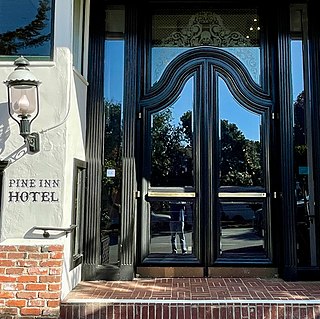
Pine Inn, once called the Hotel Carmelo, is one of the early first-class Arts and Crafts, Tudor, Spanish style hotels established in Carmel-by-the-Sea, California. The Pine Inn is a historical resource dating back to 1889 when pioneer Santiago J. Duckworth built Hotel Carmelo. James Franklin Devendorf, renamed the hotel the "Pine Inn" in 1904. Today, it is a full-service hotel. The Pine Inn qualified for inclusion in the city's Downtown Historic District Property Survey, and was registered with the California Register of Historical Resources on March 18, 2003. The Inn is significant under the California Register criterion 1, as the first hotel in the history of the downtown district of Carmel-by-the-Sea.

The Kocher Building, also known as La Giralda is a two-story steel and concrete framed Spanish Eclectic style commercial building in Carmel-by-the-Sea, California. It was designated as an important commercial building in the city's Downtown Historic District Property Survey, on September 4, 2002.

The Carmel Weavers Studio, also known as Cottage of Sweets, is a historic Tudor-style English cottage in Carmel-by-the-Sea, California. It was designed by Edward G. Kuster and constructed by Lee Gottfried in 1922 for Kuster's wife as a weaving shop. Since 1959, it has operated a candy store.

The Seven Arts Shop, is a one-story, wood-frame Tudor Storybook retail shop in Carmel-by-the-Sea, California. It has been designated as a significant commercial building in the city's Downtown Historic District Property Survey, and was recorded with the Department of Parks and Recreation on January 23, 2002.

The Seven Arts Building, is a one-and-one-half-story, Tudor Revival-style commercial building in downtown Carmel-by-the-Sea, California.

Sade's, is a historic Tudor-style English cottage in downtown Carmel-by-the-Sea, California. It was designed and constructed by Lee Gottfried in 1925, for novelist and dramatist Harry Leon Wilson and his wife Helen MacGowan Cooke as a flower shop and dress shop. In the 1930s, Sade was a former Ziegfeld Follies dancer, made the lower level into a restaurant and Bohemian bar. It continues to be a restaurant with outdoor seating.
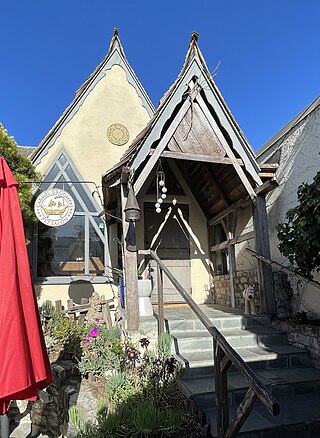
The Lemos Building is a historic Craftsman Fairy tale commercial building in downtown Carmel-by-the-Sea, California. It was built in 1929, by Louis Anderson, based on master builder Hugh W. Comstock's adjacent Tuck Box design. The building was designated as a significant commercial building in the city's Downtown Historic District Property Survey, and was recorded with the Department of Parks and Recreation on October 8, 2002.
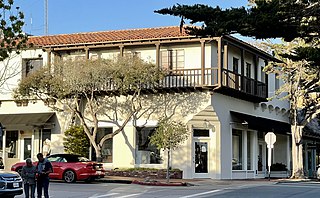
The Goold Building is a historic two-story concrete commercial building in downtown Carmel-by-the-Sea, California. The building is an example of Spanish Colonial Revival and Monterey Colonial styles. The building qualified as an important commercial building in the city's downtown historic district property survey and was registered with the California Register of Historical Resources on February 3, 2003. The building been used as a retail store since 1990s.

The Bernard Wetzel Building is a historic Spanish Eclectic Revival-style building in downtown Carmel-by-the-Sea, California. It was designed and built by Frederick Bigland for Courland J. Arne, Carmel's first barbershop. It continues to operate as a retail store today.
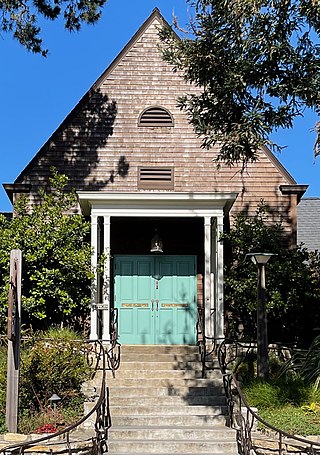
Carmel City Hall, is the seat of the municipal government of Carmel-by-the-Sea, California. It is a historic commercial building in the Carmel downtown district, located on Monte Verde Street and 7th Avenue. It is a good example of Shingle and American Craftsman architectural that was built in the 1910s. The building qualified as an important building in the city's downtown historic district property survey and was recorded with the California Register of Historical Resources on November 22, 2002.
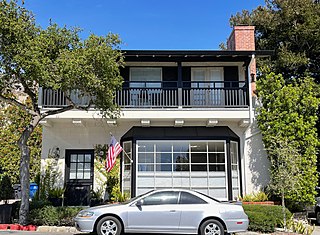
The Spinning Wheel Restaurant, is a historic commercial building in Carmel-by-the-Sea, California. It was built in 1952, by Monterey Peninsula Builders and designed by architect Edwin Lewis Snyder as a restaurant. It is an example of a Monterey Colonial architecture style building. The structure qualifies as an important building in the city's downtown historic district property survey and was recorded with the California Register of Historical Resources on June 5, 2006.

The Enchanted Oaks Building, is a historic commercial building, built in 1927, in Carmel-by-the-Sea, California, United States. The structure is recognized as an important commercial building in the city's Downtown Conservation District Historic Property Survey, and was nominated and submitted to the California Register of Historical Resources on January 29, 2003. The building is occupied by the Silvestri Vineyards.
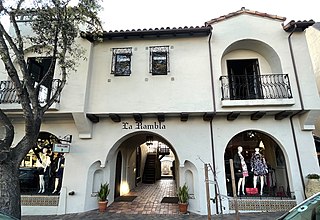
The La Rambla Building is a historic commercial building, built in 1929, in Carmel-by-the-Sea, California. The structure is recognized as an important Spanish Eclectic-style building in the city's Downtown Conservation District Historic Property Survey, and was nominated and submitted to the California Register of Historical Resources on January 30, 2003.

Richardson Log Cabin is a historic building that was built in 1902, by George H. Richardson, an Alameda attorney. The structure is recognized as significant as one of the oldest residential buildings in Carmel-by-the-Sea, California and the earliest known residence of American poet Robinson Jeffers and his wife Una. It was nominated by the Carmel City Council and a historical building and an application was submitted to the California Register of Historical Resources on May 20, 2002.
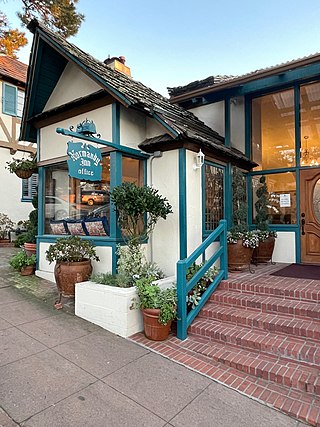
The Normandy Inn is a historic French provincial-style complex of buildings in Carmel-by-the-Sea, California, designed by Robert Stanton and built in 1936 by Fred Ruhl. The Normandy Inn has been recognized by the city as a historical resource and submitted to the California Register of Historical Resources on November 10, 2002. The Inn is an early example of the French provincial-style of architecture from the period between 1903 and 1930 in Carmel, and the most well-preserved remaining example of Robert Stanton's early architectural design work.
Percy Parkes was an American master builder in Carmel-by-the-Sea, California. Parkes was one of the main progressive builders in Monterey County through the 1920s and 1930s, and the first contractor to build homes on Scenic Drive. His best known commercial buildings are the Seven Arts Building (1928), the Dummage Building (1924), and the Percy Parkes Building (1926). His American Craftsman-style, influenced by the Arts and Crafts movement, is evident in the buildings he constructed during that time.
Samuel J. Miller, also known as Sam Miller, was a builder and carpenter in Carmel-by-the-Sea, California, United States. He had an influence on the character and architecture of Carmel during his career.

Allen Knight, was an American merchant seaman and political figure in Carmel-by-the-Sea, California. He is best known for his service on the Carmel City Council, including a two-year term as mayor, and for co-founding the Sundial Lodge. In 2016 the San Francisco Maritime National Park Association acquired the Allen Knight's maritime collection.
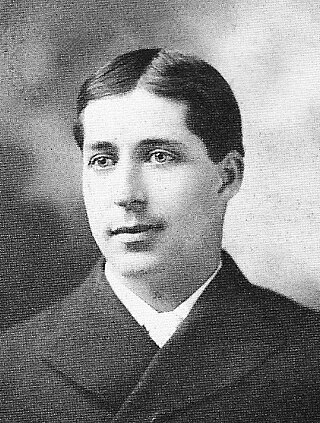
Fred Ruhl was an American master builder in Monterey County, California. He is best known for his contributions to the architecture of Pebble Beach, and Carmel-by-the-Sea, most notably for building the Flanders Mansion, listed on the National Register of Historic Places. He worked closely with architect Robert Stanton to build the Normandy Inn on Ocean Avenue in Carmel.



















